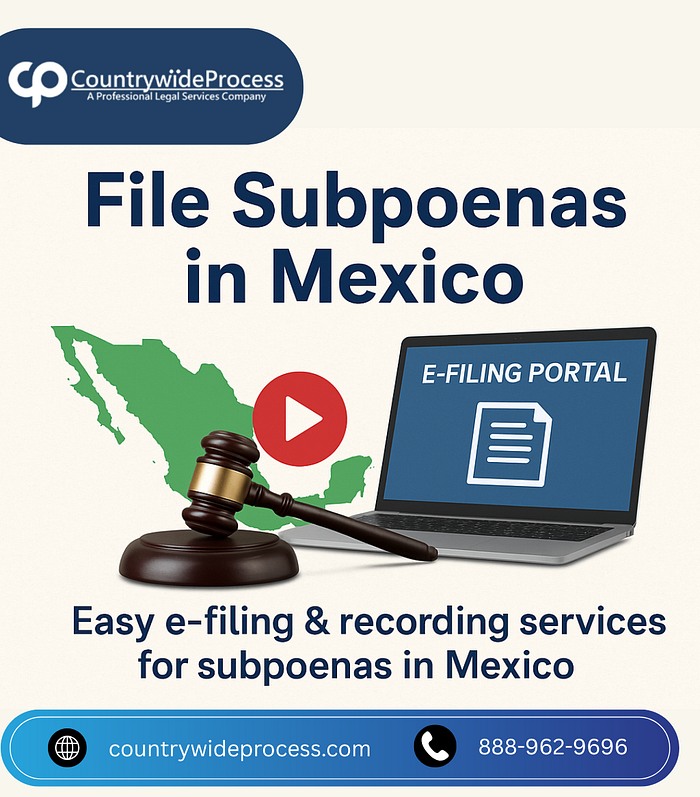How to File a Subpoena in Mexico: A Step-by-Step Guide for U.S. Litigants
When legal matters cross international borders, the process can quickly become complicated. Understanding how to file a subpoena in Mexico is essential for U.S. attorneys, corporations, and individuals involved in cross-border cases. From navigating foreign legal systems to managing document authentication, the process requires precision and expertise. Thankfully, with modern tools like an e-filing portal and trusted e-recording services, this once daunting task has become far more efficient and accessible.

Why You Might Need to File a Subpoena in Mexico
If your case involves witnesses, evidence, or business entities located in Mexico, you may need to issue a subpoena abroad. This could be for civil, commercial, or family law cases where vital documents or testimony are held by Mexican individuals or institutions.
Filing a subpoena internationally ensures you can legally obtain the information you need — while respecting Mexico’s legal framework and international treaties like the Hague Evidence Convention.
Step 1: Understanding Legal Requirements
Before proceeding, it’s crucial to understand how to file a subpoena in Mexico in compliance with international and local regulations. The Hague Evidence Convention governs how judicial cooperation between the U.S. and Mexico occurs. It ensures that evidence requests are transmitted through official channels and executed according to local laws.
This process usually involves:
- Preparing a formal “Letter of Request.”
- Submitting it to the U.S. Central Authority.
- Forwarding it to Mexico’s designated authority for review and execution.
Each step requires precision, as incomplete or improperly translated documents can delay proceedings.
Step 2: Preparing the Necessary Documentation
To file a subpoena internationally, you’ll need to gather:
- A certified copy of the subpoena.
- Case details (court, parties, and purpose).
- A translated Letter of Request in Spanish.
- Supporting documents required by Mexican authorities.
Working with experienced professionals like Countrywide Process ensures your paperwork meets both U.S. and Mexican standards — reducing delays and avoiding rejection due to formatting or translation errors.
Step 3: Using an E-Filing Portal to Simplify the Process
Gone are the days when international filings relied entirely on mail or courier. Today, a secure e-filing portal can make the process seamless and transparent.
With an e-filing portal, you can:
- Upload and submit your subpoena digitally.
- Receive confirmation and status updates instantly.
- Avoid the delays of traditional paper filing.
For example, Countrywide Process’s digital platform allows legal professionals to file, track, and manage international subpoenas with ease. It’s a secure way to ensure that your documents are handled properly from submission to delivery.
Step 4: Utilizing E-Recording Services for Document Authentication
When handling international legal filings, document authenticity is key. E-recording services help verify and store legal documents electronically — creating a secure, timestamped record of every step.
Using e-recording services offers benefits such as:
- Faster verification and certification.
- Reduced risk of lost or damaged documents.
- Easy access to digital copies for reference.
Since Mexican authorities often require certified documents before processing subpoenas, e-recording ensures your records meet the necessary legal standards. It also provides a reliable audit trail for your peace of mind.
Step 5: Submitting Through the Appropriate Channels
Once your subpoena and supporting documents are ready, they must be transmitted through the official channels defined under the Hague Convention. Typically, your Letter of Request will be sent:
- From your U.S. court to the Department of Justice (Central Authority).
- Then, from the U.S. Central Authority to Mexico’s designated judicial authority.
- Finally, to the local court in Mexico for execution.
This process can take several weeks, depending on the complexity of your request. Having professional support ensures that each stage moves smoothly, without unnecessary back-and-forth between agencies.
Step 6: Tracking the Progress and Following Up
Transparency is crucial when dealing with international filings. That’s why using an e-filing portal helps you track progress in real-time. You’ll receive updates about document receipt, processing status, and final acknowledgment.
Similarly, e-recording services provide a permanent record of all transactions, making it easier to verify the chain of custody and ensure compliance with court requirements.
Common Mistakes to Avoid When Filing a Subpoena in Mexico
Even experienced legal professionals can make errors when managing international filings. Some common pitfalls include:
- Submitting documents without certified translations.
- Failing to comply with Hague Evidence Convention procedures.
- Neglecting document authentication requirements.
- Not tracking submissions properly through electronic systems.
Avoiding these mistakes ensures your subpoena doesn’t face rejection or unnecessary delays.
Why Choose Countrywide Process?
Filing an international subpoena isn’t easy — but it doesn’t have to be stressful. Countrywide Process specializes in legal support services, including e-filing portals, e-recording services, and international document handling.
We help legal teams:
- File subpoenas efficiently across borders.
- Authenticate and record documents digitally.
- Stay compliant with both U.S. and foreign court standards.
Our experienced team handles the complexities so you can focus on what matters — building your case.
Final Thoughts
Learning how to file a subpoena in Mexico empowers you to manage cross-border legal matters confidently. With the right combination of professional guidance, digital tools like e-filing portals, and reliable e-recording services, you can streamline the process and avoid unnecessary complications.
If you’re ready to simplify your international filing process, contact Countrywide Process today. Our experts will ensure your subpoena is filed correctly, securely, and in full compliance with international law.
Reach out now and let Countrywide Process take the complexity out of your global legal procedures.

Comments
Post a Comment